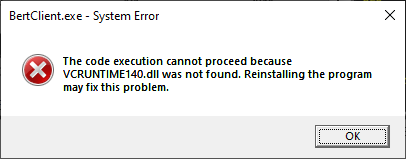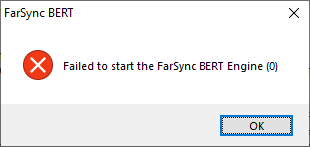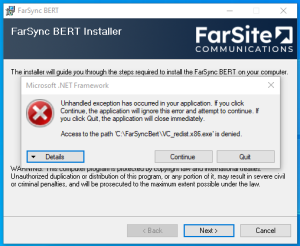Troubleshooting guide:
FarSync BERT
All the most up-to-date troubleshooting support and known issues for the FarSync BERT Tester can be found on this page.
General
For the calibration procedure, please follow the steps outlined in the FarSync BERT calibration guide.
FarSync BERT Tester-USB version 3.0.0 / FarSync BERT HS Tester-USB version 3.0.0
The FarSync BERT User Guide V3.0.0 Section 4.2 states:
Severely Errored Secs (SES) – number of secs during which > 30% of blocks are in error or of which the bit error density is >10-2
This statement also appears in the FarSync BERT’s runtime help (V3.0.0.6) under FarSync BERT-Results-Statistics/Results Table.
It should be noted that this statement applies to when the BERT is running in software mode. When hardware mode is used (i.e. the default for V3.0.0 when using FarSync Flex V2 device) the threshold value is as follows:
Severely Errored Secs (SES) – number of secs during which the bit error rate is >= 0.1%
FarSync BERT Tester-PCIe version 2.0.3
- The QRSS test pattern should not be used in conjunction with third party BERT test equipment.
FarSync BERT Tester-USB version 2.0.3
- The QRSS test pattern should not be used in conjunction with third party BERT test equipment.
- Ensure the FarSync Flex firmware is at version 2.0.3 or later (see \flash folder on the BERT software disc).
- When injecting errors please be aware that, when running at higher speeds, it is possible that multiple errors may be inserted.
- When running asynchronous tests with fixed patterns (as opposed to pseudo random patterns), it is recommended that all connections are made before starting the test. Note the patterns to use recommendations in the Pattern section of the product help documentation.
FarSync BERT Tester version 1.1.6
- The QRSS test pattern not should be used.
- Ensure FarSync Flex firmware version 1.0.4 or later is used with the FarSync BERT (see \flash folder on the BERT software disc).
- When injecting errors please be aware that, when running at higher speeds, it is possible that multiple errors may be inserted.
- When running asynchronous tests with fixed patterns (as opposed to pseudo random patterns), please ensure that all connections are made before starting the test.
- When running in ASYNC mode, the clocking option must be set to internal (INT).
- If the BERT fails to synchronise ensure your cabling meets the specification defined in FarSite Cables and also Standard Specifications. In particular check for inverted data pairs as this problem is very common.
After installing FarSync BERT software on Windows 10/11, you may encounter the following error messages when starting BERT:
“The code execution cannot proceed because VCRUNTIME140.dll was not found. Reinstalling the program may fix this problem.”

“The code execution cannot proceed because MSVCP140.dll was not found. Reinstalling the program may fix this problem.”

“Failed to start the FarSync BERT Engine (0)”

The solution is to download the latest supported Microsoft Visual C++ Redistributable from here:
Please ensure that you install both the X86 and X64 versions.
When installing FarSync BERT you may encounter the following error message:

Try running the FarSync BERT installer as Administrator:
- Right-click on the installer.
- Select Run as administrator from the list of options.

